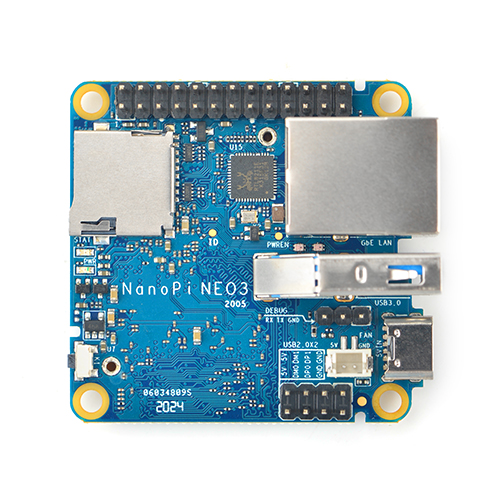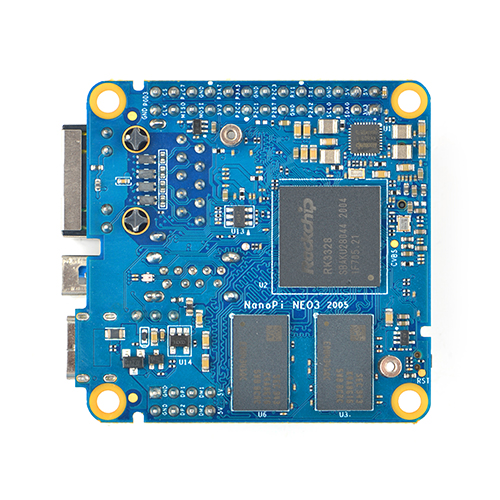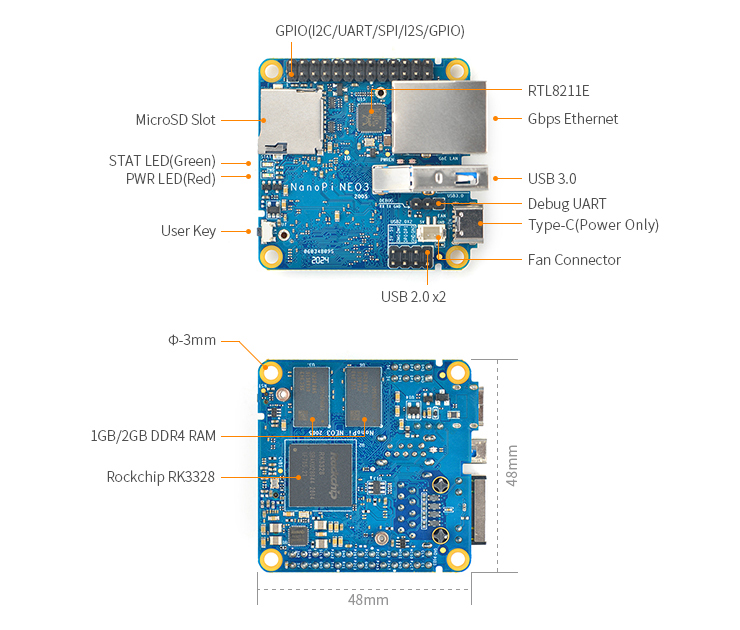NanoPi NEO3 Offers Network Storage in a Tiny Package
A tiny board with plenty of power
Raspberry Pi alternative FriendlyELEC have a history of producing ever more powerful single board computers (SBC) for a variety of applications. Their latest board the NanoPi NEO3, discovered by CNX Software seems to be a small device with which to build network storage applications.
| SoC: | RockChip RK3328, Quad-core 64-bit high-performance Cortex A53 |
| RAM: | 1GB/2GB DDR4 |
| LAN: | 10/100/1000M Ethernet with unique MAC |
| USB Host: | 1x USB3.0 Type A and 2x USB2.0 on 2.54mm pin header |
| MicroSD: | MicroSD x 1 for system boot and storage |
| Fan: | 2Pin JST ZH 1.5mm Connector for 5V Fan |
| GPIO: | 2.54mm pitch 26 pin-header, include I2C, UART, SPI, I2S, GPIO |
| Power: | 5V/1A, via Type-C or GPIO |
| PCB Dimensions: | 48 x 48mm (1.89 inch x 1.89 inch) |
| Working Temperature: | -20℃ to 70℃ |
| Weight: | 22g |



The RockChip RK3328 System on Chip (SoC) is quite an old SoC, released in 2016, but it is still a powerful chip for such a small board. Providing a quad core Arm Cortex A53 and MAli-450MP4 GPU, add in 1GB or 2GB of DDR4, USB 3 and USB C power and we have an interesting board, as long as it is cost effective. Network connectivity is limited to a single Gigabit Ethernet port (RTL8211E). There is no HDMI or other video outputs on the board, which means all control is via a remote terminal.

Storage is available via a microSD card slot, sadly there is no space for any SATA or NVME storage options. GPIO access is provided via a 26 pin interface, which features I2C, UART, SPI and I2S. Operating system support is currently an unknown quantity, but it is a good bet that operating systems for other RockChip boards will be compatible.
Based on the size of the board, slightly larger than a Raspberry Pi Zero W, and the power being roughly equal to a Raspberry Pi 3B, we would hope to see this board come in at around $20, with the 2GB model for a few dollars more.
Get Tom's Hardware's best news and in-depth reviews, straight to your inbox.

Les Pounder is an associate editor at Tom's Hardware. He is a creative technologist and for seven years has created projects to educate and inspire minds both young and old. He has worked with the Raspberry Pi Foundation to write and deliver their teacher training program "Picademy".
-
Rdslw microsd is topping around 100MB's so unless usb3.0 also can take a speedy pendrive, it does not make a lot of sense with that gigabit ethernet.Reply
hmmm true tiny network storage. -
ftw2 ReplyFindecanor said:Only MicroSD storage ...
Clickbait headline. Thanks for nothing.
I know right... I was expecting nvme, sata, or 2.5g ethernet. Any of which may have been an interesting product. -
Giroro ReplyRdslw said:microsd is topping around 100MB's so unless usb3.0 also can take a speedy pendrive, it does not make a lot of sense with that gigabit ethernet.
hmmm true tiny network storage.
Theres only 125 MegaBytes in a Gigabit (1,000 / 8). The real-world speed of gigabit Ethernet is about 118 MB/S. -
misanthropic-gamer In spite of the haters (yes, reference to the Haters Annual Ball), I think this is a step in the right direction. I would like to see all of the standard interfaces smacked-down the micro.Reply -
deesider Reply
I don't think it is total clickbait - it depends on context. As a network storage device it could be better, but this device is a major step up from the OrangePi Zero for example - which is small, headless and very cheap, but only has USB2 and 100M ethernet.ftw2 said:I know right... I was expecting nvme, sata, or 2.5g ethernet. Any of which may have been an interesting product.
Plug in a USB HDD and you have a cheap, very configurable NAS. -
OldSurferDude I find this device interesting. I'm using a headless RPi to coordinated a number of Arduino Nanos all with nRF24 radios. The RPI though, connects to the network with WiFi, so that estimated $20 is bumped up by the cost of a micro-router.Reply
Since this devices is designed to be headless, the OS has to come preconfigured for remote access. That could be tricky, particularly for a GUI. Correct me if I'm wrong, but don't remote access programs like VNC use the video chip? So no GUI at all? -
deesider Reply
It doesn't have a built in video output, but the SoC includes a GPU, so VNC should still run fine. Apparently it is also possible to fake a GPU on a linux system if required to run VNC.OldSurferDude said:Since this devices is designed to be headless, the OS has to come preconfigured for remote access. That could be tricky, particularly for a GUI. Correct me if I'm wrong, but don't remote access programs like VNC use the video chip? So no GUI at all?